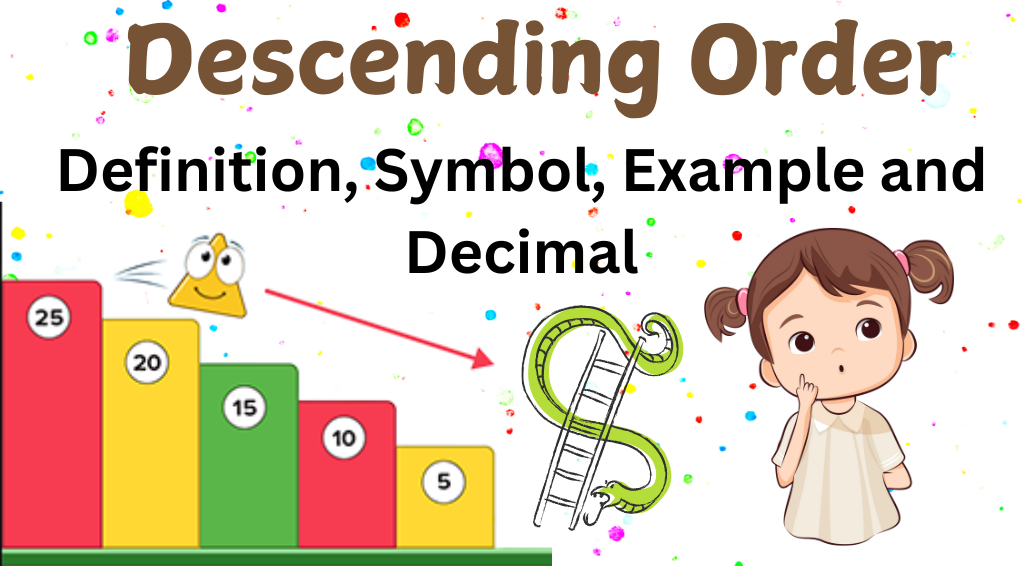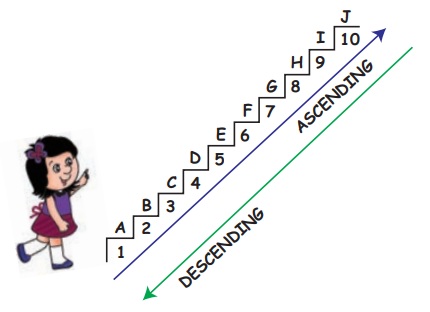Descending Order: Definition, Symbol, Example and Decimal
Descending Order refers to arranging numbers or values from the highest to the lowest. Learn how to organize data in descending order with examples and tips.
Descending order is the arrangement of numbers or values from the highest to the lowest. This concept is widely used in mathematics, data organization, and sorting tasks.
When we order items in a sequence, placing the largest value first and continuing towards the smallest, we are using descending order. This process is essential in many real-world applications, such as ranking scores, organizing resources, or analyzing data trends.
For example, when sorting test scores from highest to lowest, we are following a descending order. It is the opposite of ascending order, where values are arranged from smallest to largest. Understanding how to arrange numbers in descending order is a fundamental skill for handling numbers and data effectively.
What is Descending Order
Descending order refers to the arrangement of numbers, letters, or other items from the highest to the lowest value. In mathematics, when we organize a set of numbers in descending order, we start with the largest number and proceed to the smallest. For example, if we have the numbers 8, 3, 5, and 1, arranging them in descending order would be 8, 5, 3, and 1.
This concept is not limited to numbers but applies to letters, where alphabetical characters can be arranged from Z to A. Descending order is commonly used in various fields, including data analysis, statistics, and programming, as it helps quickly identify the largest values and understand the distribution of data.
By organizing information in descending order, we can enhance clarity and facilitate easier comparisons, making it a valuable tool in both academic and practical applications.
Descending Order Symbol
The descending order symbol, “>”, represents an arrangement or sequence of numbers, values, or items in order from the largest to the smallest. It is commonly used in mathematics, data analysis, and many other fields to express a decreasing sequence.
The opposite of descending order is ascending order, where numbers or values are arranged from smallest to largest (using the “<” symbol).
Examples:
- In Numbers:
- 10 > 8 > 5 > 3 > 1
- This means 10 is greater than 8, which is greater than 5, and so on.
- In Sorting Data:
- When organizing a list of scores from highest to lowest, you might arrange them like this: 95 > 90 > 85 > 80 > 75.
- In Logical Expressions:
- 7 > 5 means 7 is greater than 5
Descending Order Examples
Here are some examples of arranging numbers, letters, and other items in descending order:
1. Numbers
- Example 1: Arrange the following numbers : 12, 5, 8, 20, 3
Descending Order: 20, 12, 8, 5, 3 - Example 2: Arrange the following numbers: 45, 67, 23, 89, 12
Descending Order: 89, 67, 45, 23, 12
2. Decimals
- Example: Arrange the following decimal numbers: 3.5, 2.1, 4.8, 1.9
Descending Order: 4.8, 3.5, 2.1, 1.9
3. Negative Numbers
- Example: Arrange the following negative numbers: -1, -5, -3, -10
Descending Order: -1, -3, -5, -10
(Note: In this case, -1 is greater than the other negative numbers.)
4. Alphabets
- Example: Arrange the following letters in: D, A, C, B
Descending Order: D, C, B, A
(This is based on the alphabetical order from Z to A.)
5. Words by Length
- Example: Arrange the following words in descending order based on their length: apple, banana, fig, cherry
Descending Order: banana (6), cherry (6), apple (5), fig (3)
6. Scores
- Example: Arrange the following test scores in descending order: 78, 95, 88, 62, 100
Descending Order: 100, 95, 88, 78, 62
7. Ages
- Example: Arrange the following ages: 25, 30, 18, 22, 40
Descending Order: 40, 30, 25, 22, 18.
Decimal Numbers in Descending Order
Decimals are arranged in descending order by examining the digits from left to right based on their place value. Start by comparing the whole number part of the decimal numbers.
If two or more numbers have the same whole number part, compare the digit in the tenth place (the first digit to the right of the decimal point).
If the tenth digits are also the same, move to the hundredth place and continue this process as needed. This systematic approach ensures the correct order from largest to smallest.
For instance, 8.76 > 6.55 > 5.98 > 3.89 > 2.45 > 1.23 demonstrates the arrangement of decimal numbers in descending order.
Read More – Co Prime Numbers – Definition, Properties and Examples

My name is Khushi, I am a content writer and I provide news related to government jobs and I am from Rajasthan and I only write on this website.


